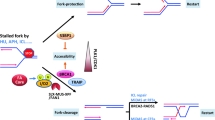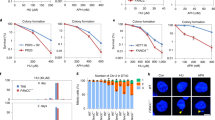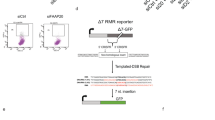Abstract
In mammalian cells, nonhomologous end-joining is the predominant mechanism to eliminate DNA double strand breaks. Such events are at the origin of deletion mutagenesis and chromosomal rearrangements. The hallmark of Fanconi anemia, an inherited cancer prone disorder, is increased chromosomal breakage associated to over-production of deletions. Knowing that double strand breaks are at the origin of deletion mutagenesis, the question arises whether their processing is affected in FA. We set up a «host cell end-joining assay» to analyze the fate of double strand breaks into extrachromosomal substrates transiently replicated in normal and FA-D lymphoblasts. Although no difference in plasmid survival was found, blunt-ended breaks were sealed with significantly lower fidelity in FA cells, resulting in a higher deletion frequency and a larger deletion size. The results suggest that FA-D and FA-B gene products are likely to play a role in end-joining fidelity of specific DNA double strand breaks.
Similar content being viewed by others
Literature Cited
Auerbach, A. D., and Wolman, S. R., (1976).Nature 261:494–496.
Liu, J.M., Buchwald, M., Walsh, C.E., and Young, N.S. (1994).Blood 84:23995–4007.
Strathdee, C.A., Duncan, A.M.V., and Buchwald, M. (1992a).Nature Genet. 1: 196–198.
Joenje, H., Oostra, A.B., Wijker, M., DiSumma, F.M., van Berkel, C.G.M., Rooimans, M.A., Ebell, W., van Weel, M., Pronk, J.C., Buchwald, M., and Arwert, F. (1997).Am. J. Hum Genet. 61:940–944.
Papadopoulo, D., Guillouf, C., Mohrenweiser, H., and Moustacchi, E. (1990).Proc. Natl. Acad. Sci. U.S.A. 87:8383–8387.
Bredberg, A., Sandor, Z., and Brant, M. (1995)Carcinogenesis 16:555–561.
Sala-Trepat, M., Boyse, J., Richard, P., Papadopoulo, D., and Moustacchi, E. (1993).Mutation Res. 289:115–126.
Roth, D.B., and Wilson, J.H. (1985).Proc. Natl. Acad. Sci. U.S.A. 82:3355–3359.
Roth, D.B., and Wilson, J.H. (1986).Mol. Cell. Biol. 6:4295–4304.
Lehman, C.W., Trautman, J.K., and Carroll, D. (1994).Nucleic Acids Res. 22:434–442.
Pfeiffer, P., Thode, S., Hancke, J., and Vielmetter, W. (1994).Mol. Cell. Biol. 14:888–895.
Crespi, C.L., and Thilly, W.G. (1984).Mutation Res. 128:221–230.
Duckworth-Rysiecki, G., Cornick, K., Clarke, C.A., and Buchwald, M. (1985).Somatic Cell Mol. Genet. 11:35–41.
Papadopoulo, D., Porfirio, B., and Moustacchi, E. (1990).Cancer Res. 50:3289–3294.
Kallenbach, S., Goodhardt, M., and Rougeon, F. (1990).Nucleic Acids Res. 18:6730.
Kleinschmidt, A.K. (1968).Methods in Enzymology 12, Part B:361–377.
Rousset, S., Nocentini, S., Revet, B., and Moustacchi, E. (1990).Cancer Res. 50:2443–2448.
Birnboim, H.C., and Doly, J. (1979).Nucleic Acids Res. 7:1513.
Papadopoulo, D., Laquerbe, A., Guillouf, C., and Moustacchi, E. (1993).Mutation Res. 294:167–177.
Pearson, W.R., and Lipman, D.J. (1988).Proc. Natl. Acad. Sci. U.S.A. 85:2444–2448.
Thacker, J. (1986).Mutation Res. 160:267–275.
Liber, H.L., Call, K.M., and Little, J.B. (1987).Mutation Res. 178:143–153.
Rigaud, O., Papadopoulo, D., and Moustacchi, E. (1993).Radiation Res. 133:94–101.
Rünger, T.M., and Kraemer, K.H. (1989).The EMBO J. 8:1419–1425.
Rünger, T.M., Poot, M., and Kraemer, K.H. (1992).Mutation Res. 293:47–54.
Rünger, T.M., Bauer, C., Dekant, B., Möller, K., Sobotta, P., Czerny, C., Poot, M., and Martin, G.M. (1994).J. Invest. Dermatol. 102:45–48.
Rünger, T.M., Sobotta, P., Dekant, B., Möller, K., Bauer, C., and Kraemer, K.H. (1993).Toxicol. Letters 67:309–324.
Thacker, J. (1989).Mutation Res. 220:187–204.
Tatsumi-Miyajima, J., Yagi, T., Takebe, H. (1993).Mutation Res. 294:317–323.
Friedberg, E.C., Walker, G.C., and Siede, W. (1995).DNA Repair and Mutagenesis, ASM Press, Washington.
Gluckman, E., Devergie, A., and Dutreix, J. (1983).Br. J. Haematol. 54:431–440.
Jackson, S.P., and Jeggo, P.A. (1995).TIBS 20:412–415.
Gu, Y., Jin, S., Gao, Y., Weaver, D.T. and Alt, F.W. (1997).Proc. Natl. Acad. Sci. U.S.A. 94:8076–8081.
Grawunder, U., Wilm, M., Wu, X., Kulesza, P., Wilson, T.E., Mann, M. and Lieber, M.R. (1997).Nature,388:492–495.
Liang, F. and Jasin, M. (1996).J. Biol. Chem.,271:14405–14411.
Harrington, J., Hsieh, C.L., Gerton, J., Bosma, G. and Lieber, M.R. (1992).Mol. Cell. Biol.,12:4758–4768.
Thacker, J., Chalk, J., Ganesh, A., and North, P. (1992).Nucleic Acids Res. 20:6183–6188.
King, J.S., Valcarcel, E.R., Rufer, J.T., Phillips, J.W., and Morgan, W.F. (1993).Nucleic Acids Res. 21:1055–1059.
Strathdee, C.A., Gavish, H., Shannon, W.R., and Buchwald, M. (1992b).Nature 358:434.
Lo Ten Foe, J.R., Rooimans, M.A., Bosnoyan-Collins, L., Alon, N., Wijker, M., Parker, L., Lightfoot, J., Carreau, M., Callen, D.F., Savoia, A., Cheng, N.C., van Berkel, C.G.M., Strunk, M.H.P., Gille, J.J.P., Pals, G., Kruyt, F.A.E., Pronk, J.C., Arwert, F., Buchwald, M., and Joenje, H. (1996)Nature Genet. 14:320–323.
The Fanconi anaemia/Breast cancer consortium (1996).Nature Genet. 14:324–328.
Yamashita, T., Barber, D.L., Zhu, Y., Wu, N., and D'Andrea, A.D. (1994),Proc. Natl. Acad. Sci. U.S.A. 91:6712–6716.
Youssoufian, H. (1994).Proc. Natl. Acad. Sci. U.S.A. 91:7975–7979.
Lightfoot, J., Alon, N. and Buchwald, M. (1997). Abstract in Workshop on Research Directions in Fanconi Anemia.
Kupfer, G.M., Naf, D., Suliman, A., Pulsipher, M. and D'Andrea, A.D. (1997).Nature Genet. 17:487–490.
Author information
Authors and Affiliations
Rights and permissions
About this article
Cite this article
Escarceller, M., Rousset, S., Moustacchi, E. et al. The fidelity of double strand breaks processing is impaired in complementation groups B and D of fanconi anemia, a genetic instability syndrome. Somat Cell Mol Genet 23, 401–411 (1997). https://doi.org/10.1007/BF02673750
Received:
Accepted:
Issue Date:
DOI: https://doi.org/10.1007/BF02673750




